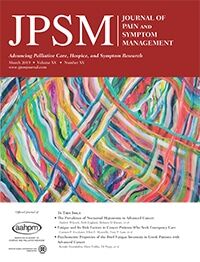
The future of hospice and palliative medicine depends on the strength and vision of its leaders. Today, we have an opportunity to shape that future by supporting the development of […]

The future of hospice and palliative medicine depends on the strength and vision of its leaders. Today, we have an opportunity to shape that future by supporting the development of […]

Tochi Nwaneri Nwosu, MDInternal Medicine Oakland, CA Medicine program sponsors residents from underrepresented communities who are interested in hospice and palliative medicine (HPM). Research shows that providing culturally effective HPM […]
Vanessa Battista, DNP MBA CPNP-PC CHPPN FPCN FAANSenior Director, Palliative Care Dana-Farber Cancer Institute Boston, MA AAHPM is proud to highlight members who embody the values of leadership, collaboration, and […]

Stay up to date with the latest research and clinical insights in palliative care and pain management with the Journal of Pain and Symptom Management.
Advance your career in hospice and palliative care by becoming a member of AAHPM, which provides you with access to discounts, educational resources, publications, networking opportunities, and more.